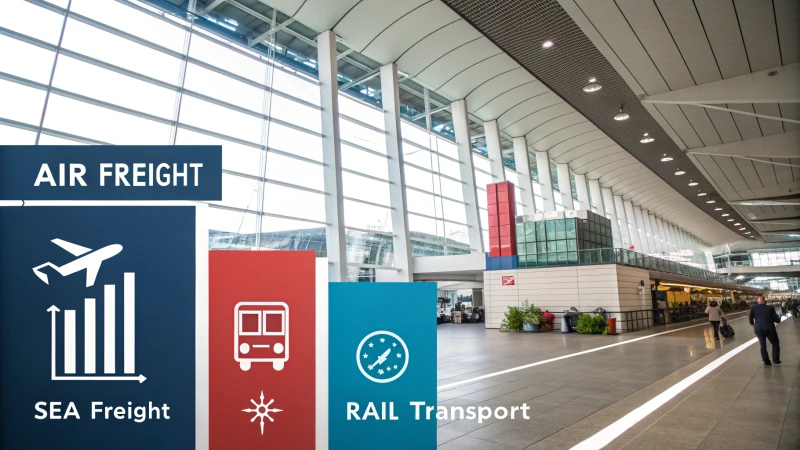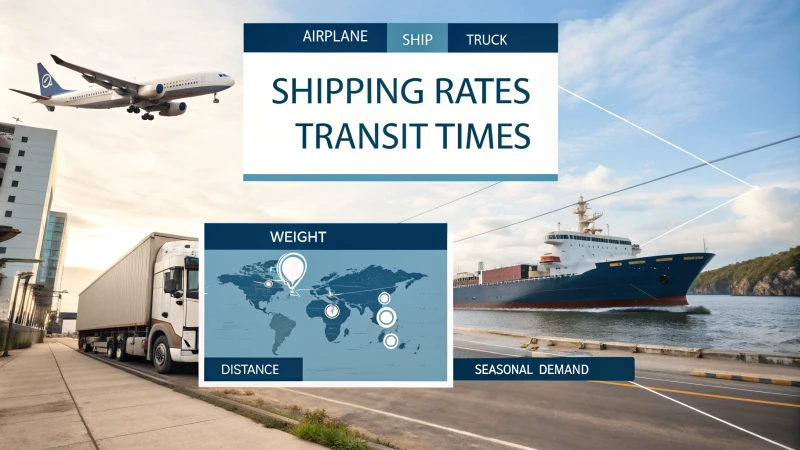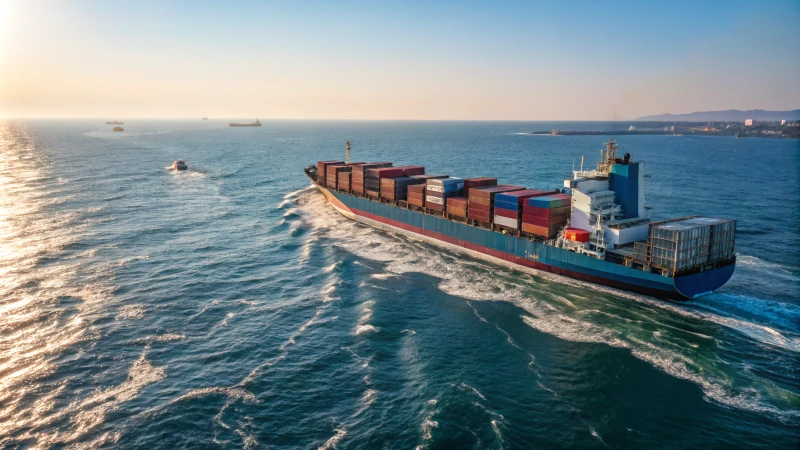Navigating the world of shipping from China to France can feel like piecing together a puzzle.
Shipping from China to France can be done via express, air, sea, or rail freight. Express is fastest at 3-6 days but costly. Air freight takes 6-9 days, rail 20-25 days, and sea 28-38 days. Costs vary: air ($3-$8/kg), sea (20ft container: $2800-$3200), and express ($30-$45/kg).
I remember the first time I had to choose a shipping method for my business; it was like staring at a menu in a foreign language. I had tight deadlines but also needed to keep costs in check. Balancing speed and expense was tricky, but understanding each option's nuances helped me make the right choice. Let's break it down together, so your journey can be smoother than mine was back then.
Once you grasp these basics, it becomes clearer why sometimes paying a little more for express shipping might save you stress during peak seasons. Alternatively, opting for sea freight might be just the ticket when you're planning ahead and want to maximize your budget. Exploring these options with Gofreighter can help simplify decisions, letting you focus on growing your business instead of worrying about logistics.
Express shipping from China to France takes 3-6 days.True
Express shipping is the fastest method, taking only 3-6 days.
Sea freight from China to France costs $30-$45/kg.False
Sea freight is charged per container, not per kg, costing $2800-$3200.
How Do Different Shipping Methods Compare in Cost and Time?
Ever wondered why your package delivery feels like a waiting game? Choosing the right shipping method might just hold the key.
Shipping methods differ in cost and delivery time. Express shipping is quick but expensive; sea freight is slower yet cheaper. Air and rail freight offer a balance, providing moderate speed and cost.

I've often found myself in a bind trying to decide the best shipping method for my business. It's a delicate balance between cost and time—a choice that can significantly impact my bottom line and customer satisfaction. Let me share what I've learned over the years.
Express Shipping: The Quickest Route
There was this one time when I needed a shipment of electronics urgently. DHL came through with express shipping, delivering within 4 days. But boy, did it cost me! At $30 to $45 per kilogram, it’s perfect for when you're in a pinch and need speed over savings.
Air Freight: Balancing Speed and Cost
For those of us who are always looking for a sweet spot between speed and cost, air freight is a lifesaver. My experience with air freight has been quite positive—deliveries usually take about 6 to 9 days, and at $3 to $8 per kilogram, it’s affordable. It’s my go-to when I need to balance urgency with budget.
Sea Freight: Cost-Efficient for Bulk
If you're anything like me, always dealing with bulk shipments, sea freight is your best friend. Once, I shipped an entire container of gadgets; it took about 30 days to arrive but saved me a ton of money. A 20-foot container costs roughly $2800 to $3200—ideal for when time isn't of the essence.
Rail Freight: A Middle Ground
Then there’s rail freight—sort of the Goldilocks of shipping. Not too fast, not too slow, just right for certain shipments. It takes about 20 to 25 days and works well for cross-continental hauls where sea might take forever.
Comparative Table: Costs and Delivery Times
| Shipping Method | Cost | Delivery Time |
|---|---|---|
| Express | $30-45/kg | 3-6 days |
| Air Freight | $3-8/kg | 6-9 days |
| Sea Freight (20ft) | $2800-3200 | ~30 days |
| Rail Freight | Moderate | 20-25 days |
Understanding the differences in shipping1 methods has truly helped me optimize my logistics strategy. Picking the right option ensures my deliveries are timely without blowing the budget on transport costs.
Express shipping costs $30 to $45 per kilogram.True
Express shipping is the fastest but most expensive option, costing $30-$45/kg.
Sea freight is faster than air freight.False
Sea freight takes 28-38 days, while air freight takes 6-9 days.
What Factors Affect Shipping Rates and Transit Times?
When I first dipped my toes into the world of shipping, I was overwhelmed by the maze of rates and transit times. It felt like trying to solve a puzzle without all the pieces.
Shipping rates and transit times depend on several key factors: transportation mode, shipment size, weight, distance, and seasonal demand. Choosing between air, sea, rail, or express methods will affect both cost and speed.

Modes of Transportation
Choosing the right mode of transport is like picking the best route for a road trip. Each option has its own set of pros and cons. When I first started shipping goods, I quickly learned that air freight is the equivalent of taking the highway—it’s fast but pricey. Shipping by air freight2 usually takes 6–9 days, perfect for when you need things yesterday. On the flip side, sea freight is like taking the scenic route—less costly but much slower, with delivery times ranging from 28–38 days.
Rail sits comfortably in the middle, striking a balance between cost and speed with an average transit time of 20–25 days. Then there's express shipping, offered by companies like DHL or FedEx, which is like teleporting your goods—super quick at 3–6 days but definitely comes with a premium price tag.
| Mode | Transit Time | Cost Estimate |
|---|---|---|
| Air | 6–9 days | $3-$8 per kg |
| Sea | 28–38 days | $2800-$5600 per container |
| Rail | 20–25 days | Cheaper than air |
| Express | 3–6 days | $30-$45 per kg |
Shipment Size and Weight
Early on in my logistics journey, I realized that size and weight are king when it comes to shipping costs. Larger or heavier shipments often mean higher fees. It's like booking extra baggage on a flight—it adds up quickly. So, whenever possible, I try to consolidate shipments to take advantage of economies of scale.
Distance and Route
Shipping is very much like navigating a map; the further you go, the more resources and time it takes. One thing I’ve learned is that optimizing the route can significantly reduce transit times and costs. Even small adjustments in the planned path can yield big savings.
Seasonal Variations
The first holiday season I encountered in this business was an eye-opener. Demand surged, and so did prices—sometimes up by 10-50%3. During these peak seasons, transit times also stretched by 3-15 days due to congestion. Planning ahead became my mantra to avoid these pitfalls.
Fuel Costs and Surcharges
Just when I thought I had my budget nailed down, fuel prices threw a wrench into my plans. Shipping costs can fluctuate with these changes as carriers impose fuel surcharges to stay afloat. Keeping an eye on these trends helps me anticipate potential spikes in expenses.
Customs and Duties
Navigating customs is like trying to solve a Rubik’s cube blindfolded. Every country has its own set of rules, and non-compliance can lead to costly delays. Partnering with a savvy freight forwarder was a game-changer for me—smooth sailing became possible.
Technological Innovations
Embracing technology in logistics has been revolutionary. Real-time tracking systems not only give me peace of mind but also allow for timely adjustments when delays threaten to derail plans. These tools have become an integral part of my shipping strategy.
By understanding these factors, I've been able to fine-tune my logistics strategy to strike a balance between cost efficiency and timely deliveries. Using tools like real-time tracking systems4 has further bolstered my ability to manage shipments effectively.
Air freight usually takes 6–9 days for delivery.True
Air freight is fast, taking about 6–9 days, but is costly.
Sea freight is the most expensive shipping method.False
Sea freight is cheaper than air or express, but slower.
Is Express Shipping Always Worth the Higher Cost?
Ever found yourself in a shipping dilemma, wondering if express delivery is truly worth those extra bucks? Let’s dive into this common conundrum and unravel the mysteries of express shipping.
Express shipping speeds up delivery to about 3-6 days but comes with higher costs. It's perfect for urgent needs but not always necessary for every shipment. Weigh urgency, cost, and reliability to decide if it's the right choice.

Comparing Shipping Methods
I've often found myself staring at shipping options, much like choosing between a fancy dinner or a cozy home-cooked meal. Each has its perks and price points. Here's a quick look at the usual suspects:
| Shipping Method | Transit Time | Cost (per kg) |
|---|---|---|
| Express Shipping | 3-6 days | $30-$45 |
| Air Freight | 6-9 days | $3-$8 |
| Sea Freight | 28-38 days | Varies by container size |
| Rail Freight | 20-25 days | Lower than air freight |
Every time I consider shipping from China5, I'm reminded of my first big import order, which taught me more about patience and logistics than any textbook could. Let's break down what influences these decisions.
Factors to Consider
Urgency
Remember the time I needed those gadgets yesterday, but they were still in transit? That’s when express shipping is a lifesaver. If you’ve got customers breathing down your neck or deadlines looming, it’s a reliable hero to have.
Cost vs. Benefit
I’ve had moments of hesitation, glancing at my budget while my mind races through the potential gains. Think about it like this: Is getting your product out there faster going to boost your bottom line? If yes, then maybe that extra cost isn't so daunting.
Reliability and Tracking
There was this one time I tracked a shipment down to the exact minute it was supposed to arrive. With companies like DHL and FedEx, you get peace of mind along with your package.
Peak Season6 Impacts
Anyone who's ever shopped during the holidays knows about the dreaded peak season delays and costs. Planning ahead can save you some serious stress and cash.
Alternatives to Express Shipping
So, if express seems like overkill, there are alternatives. Air freight might strike a nice balance between speed and cost, especially when time isn’t too tight.
In conclusion, choosing express shipping is like deciding whether to splurge on a luxury item; it depends on your situation. Urgency, budget, and customer expectations all play roles in what you decide. By thinking through these factors, you can find the shipping option that hits that sweet spot of efficiency and cost-effectiveness.
And when in doubt, having a partner like Gofreighter7 means you’re covered with solutions that fit like a glove.
Express shipping is always the fastest option.True
Express shipping typically delivers within 3-6 days, faster than other methods.
Sea freight is more expensive than express shipping per kg.False
Sea freight costs vary by container size, generally cheaper per kg than express.
How Do I Choose the Right Freight Forwarder for My Needs?
Choosing the right freight forwarder feels like finding the perfect dance partner for your business. It's all about trust, rhythm, and understanding your unique needs. Here's how to get it right.
To choose the ideal freight forwarder, I focus on their industry experience, global network, service range, and compliance with international regulations. This approach ensures smooth, efficient logistics management tailored to my business needs.

Understanding Your Shipping Needs
Before diving into selecting a freight forwarder, I always start by laying out my shipping requirements in detail. I consider things like shipment size, frequency, destinations, and any time constraints I might have. It's kind of like planning a road trip—knowing where I'm going helps me decide the best route and vehicle to take. Here's a handy table I use to weigh the different transportation modes8 and their characteristics:
| Mode | Transit Time | Cost (Approx.) |
|---|---|---|
| Air Freight | 6-9 days | $3-$8 per kg |
| Sea Freight | 28-38 days | $2800-$5600 per container |
| Rail Freight | 20-25 days | Cheaper than air |
Evaluating Freight Forwarder's Expertise
In my experience, having an expert who knows my industry inside out is invaluable. It's like having a guide who understands the terrain. I make it a point to ask potential forwarders about their past projects or clients in my sector. Their stories often reveal whether they can handle the unique challenges that come with my line of work.
Assessing Global Network and Partnerships
A strong global network is a freight forwarder's backbone. I look for partners with robust connections across regions I frequently ship to. During one peak season, this saved me from a logistical nightmare when another carrier fell through. Knowing they've got a web of reliable contacts offers peace of mind.
Explore options with strong international connections9.
Reviewing Service Offerings
Freight forwarders aren't just about moving goods from A to B—they offer a range of services like warehousing, customs brokerage, and supply chain consulting. I think about which of these extras could benefit my operations. The right mix can simplify processes and cut down costs.
Verifying Compliance and Certifications
Compliance is non-negotiable in international trade. I always verify that a forwarder holds the necessary certifications like C-TPAT or IATA. It’s like having insurance against unforeseen penalties and delays. Checking their track record in handling regulatory requirements gives me confidence that they can navigate complex trade laws.
Communication and Transparency
Clear communication can make or break a logistics partnership. I've learned to evaluate how transparent a forwarder is about costs and timelines. Their ability to provide regular updates on shipment status and their responsiveness is critical. It’s reassuring to know that if something goes awry, they’re just a call away and ready with solutions.
Air freight is the cheapest mode for large shipments.False
Air freight is generally more expensive than sea or rail for large shipments.
A robust network ensures better logistics flexibility.True
A strong global network allows forwarders to adapt to changes and manage shipments efficiently.
Conclusion
Shipping from China to France offers various methods: express (3-6 days, $30-$45/kg), air (6-9 days, $3-$8/kg), rail (20-25 days), and sea (28-38 days, $2800-$3200).
-
Discover detailed comparisons of various shipping methods to help you make informed decisions about your logistics strategy. ↩
-
Air freight provides fast delivery for time-sensitive shipments, making it ideal for urgent needs. ↩
-
Understanding seasonal impacts helps in planning budgets effectively by anticipating rate increases. ↩
-
Real-time tracking offers transparency in logistics, enabling proactive management of shipments. ↩
-
Explore various shipping methods from China to France to determine the best fit for your needs. ↩
-
Understand how peak seasons affect shipping prices and how to plan accordingly. ↩
-
Learn more about Gofreighter's logistics solutions and how they can optimize your shipping strategy. ↩
-
This link will help you understand the different transportation options available, aiding in selecting the most suitable mode for your needs. ↩
-
Learn why a global network is crucial for ensuring reliable and flexible shipping solutions, especially during peak periods or unexpected events. ↩




